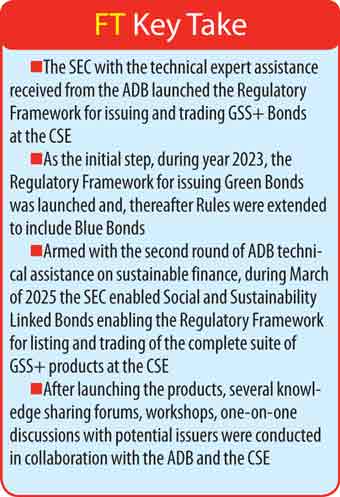Wednesday Dec 17, 2025
Wednesday Dec 17, 2025
Friday, 2 May 2025 00:45 - - {{hitsCtrl.values.hits}}

 By Securities and Exchange Commission of Sri Lanka
By Securities and Exchange Commission of Sri Lanka
The Securities and Exchange Commission of Sri Lanka (SEC) in collaboration with the technical expertise sourced from the Asian Development Bank (ADB) has facilitated the Regulatory Framework for issuing and trading a suite of Environment, Social and Governance (ESG) related Bond products at the Colombo Stock Exchange (CSE). Accordingly, issuers can now raise funds in the Capital Market by way of issuing Green, Blue, Social and Sustainability Linked (identified as GSS+) Bonds.
The Regulatory Framework for Green Bonds was published in April 2023 and subsequently was extended to include Blue Bonds. With the recent SEC approval, now issuers have the option of focusing on two additional products; Social and Sustainability Linked Bonds. Whilst Green, Blue and Social Bonds provide issuers (Sovereigns and Corporates) the impetus for directing issue proceeds towards eligible Projects that will generate positive environment and social outcomes, Sustainable Linked Bonds identified as a “filler” in the ESG space provides businesses and investors more options for financing and investing in sustainability initiatives.
In response to the calls for action on climate change stemming from global agreements such as the Paris treaty, Sri Lanka is committed to achieve carbon neutrality by year 2050. In the journey of transitioning to a low carbon economy and a cleaner Sri Lanka through the development of the ESG pillars, the Government of Sri Lanka and environmentally and socially responsible corporates could make great use of innovative sustainable financing tools such as GSS + bonds introduced at the CSE.
Putting your money where your values are: GSS+ products explained
GSS+ refers to a category of financial products designed to fund projects with positive environmental and social impacts. The following are types of sustainable bond products within the GSS+ framework.
1. Green Bonds
Green Bonds are innovative financial instruments where the proceeds are invested exclusively (either by specifying the use of the proceeds, direct project exposure, or securitisation) in eligible green projects that generate climate or other environmental benefits such as renewable energy, energy efficiency, sustainable waste management, sustainable land use (forestry and agriculture), biodiversity, clean transportation and clean water. Their structure, risk and returns are otherwise identical to those of traditional bonds. They are no different from conventional bonds where their structure, risk and return are identical to traditional bonds with the only difference being the specification that the proceeds be invested in projects that generate environmental benefits.
2. Blue Bonds
Blue Bonds are a subset of Green Bonds, where the funds raised are used to finance the resilience of marine and coastal ecosystems, particularly in line with Sustainable Development Goals (SDGs) - (Conserve and sustainably use the oceans, seas and marine resources for sustainable development).
Possible broad project categories include:
3. Social Bonds
Similar to a Green Bond, a Social Bond is a fixed income instrument where the proceeds are focused on activities with predominantly positive social outcomes. Accordingly, Social Bonds mobilise funds to finance or refinance in part or in full new and/or existing eligible social projects. Some examples of eligible social projects include ; affordable basic infrastructure (e.g. clean drinking water, sewers, sanitation, transport, energy), access to essential services (e.g. health, education and vocational training, healthcare, financing and financial services), affordable housing, employment generation and programs designed to prevent and/or alleviate unemployment stemming from socioeconomic crises, climate transition projects and/or other considerations for a “just transition” (such provision and/or promotion could include SME financing and microfinance), food security and sustainable food systems (e.g. physical, social, and economic access to safe, nutritious, and sufficient food that meets dietary needs and requirements, resilient agricultural practices; reduction of food loss and waste, and improved productivity of small-scale producers).
4. Sustainability linked bonds
Sustainability Linked Bonds differ from the other types of GSS+ Bonds in that their proceeds are not used to finance specific projects but are instead made available for general corporate purposes, with the issuer contractually undertaking to achieve predefined, measurable sustainability targets or Key Performance Indicators (KPIs). As a rule, failure to achieve these targets results in penalty payments to investors attributes to an increased coupon. The opposite is sometimes true, i.e. the coupon or payment to investors is reduced if the KPI targets are met. In both cases, sustainability-linked bonds are intended to provide the issuer with a financial incentive to achieve the sustainability targets it has set within the agreed time frame.
An example of a recently issued Sustainability Linked Bond is by Coca-Cola İçecek (CCI), which successfully launched the largest Sustainability-linked bond in Türkiye to date, with an issue size of USD 500 million. Under the terms of the bond, CCI has committed to improving its water efficiency by 13% by 2027 and 17% by 2029, aligning its financial strategy with its broader environmental sustainability goals by the time the bond reaches maturity.
In addition to the aforesaid main categories, issuers also have the option of combining both Green and Social elements and issuing a Sustainability Bond where proceeds are utilised to finance or re-finance a combination of both Green and Social Projects.
From millions to trillions: The explosive growth of Sustainable Bonds
As per World Bank data, the market expanded remarkably from just $140 billion pre-2016 to a peak of $1,239 billion in 2021, representing nearly 9x growth over this period.
After explosive growth culminating in 2021, the market experienced a moderate contraction in 2022 (to $1,020 billion) followed by slight recovery in 2023 ($1,073 billion) and 2024 ($1,125 billion).
Moreover, when it comes to product diversification, while the Green Bonds dominated the early market, there was a significant diversification with Social Bonds emerging more prominently around 2019-2020, sustainability-Linked Bonds appearing around 2020 and solidifying their presence and Transition bonds representing the smallest segment with minimal visibility.
The period between 2019-2021 marked the most dramatic growth (from $389B to $1,239B), likely influenced by the pandemic which heightened focus on both social welfare and green recovery initiatives.
However, despite the diversification, Green Bonds consistently represent the largest segment by volume throughout the entire period between pre 2016, 2016 -2024, underlining their foundational role in the sustainable finance market.
Moreover, Sustainable Bond issuances for the year 2024 reached USD 1.1 trillion which is a 5% increase from the amount recorded for 2023. Further, the cumulative amount of Green, Social, Sustainability, Sustainability-Linked, and Transition (labeled sustainable) Bonds issued in the market amounted to USD 6.2 trillion as at the end of December 2024.
Additionally, advanced markets demonstrate both greater volume and diversity in sustainable finance instruments, while Emerging Markets and Supranational issuers contribute relatively equal shares but with different compositions.
The above facts denote the maturing of the sustainable finance market, with initial explosive growth, giving way to a more stable but still substantial market with diversified product offerings across the GSS+ spectrum.
Unlocking value: The advantages of GSS+ Bond issuance and investment
These bonds offer issuers a pathway to diversify funding sources, enhance their environmental, social, and governance (ESG) profiles, and attract a broader investor base. For investors, GSS+ bonds present opportunities to achieve competitive financial returns while contributing to impactful projects that address global challenges. As the market for these bonds continues to expand, understanding their advantages is crucial for both issuers and investors aiming to make informed and responsible financial decisions.
Benefits to issuers
1. Provides the issuers with the opportunity to diversify the funding sources and attract a new pool of investors interested in sustainable investments; domestic and international
2. Issuing a Sustainable Bond enhances the issuer’s reputation as a responsible entity concerned with and adhering to ESG aspect, thereby being recognised as a contributor to achieving national SDGs
3. The strong investor demand enjoyed by Sustainable Bonds provides the issuer with the opportunity to reduce interest rates and therefore lower the cost of funds
4. Sustainable Bonds offer an effective mode of finance to cost-intensive investment projects that provide environmental and social benefits to the country
Benefits to investors
1. Offers an investment option that provides comparable financial returns whilst contributing towards the country’s economic and sustainable development
2. The respective Sustainable Bond Principes and Standards require the issuers to adhere to stringent reporting requirements which provides transparency for managing the investment
3. It gives investors a sense of self-fulfillment for contributing towards projects that save the environment and support social development
Sustainable finance under scrutiny: Regulatory standards for GSS+ instruments
As per the Listing Rules of the CSE, an entity seeking to issue GSS+ Bonds needs to adhere to the International Capital Market Association’s (ICMA) Principles and Guidelines pertaining to Green, Blue, Social or Sustainability Linked Bonds. Provided however, in the case of a Commercial Bank, Specialised Bank or Financial Institution licensed/regulated by the Central Bank of Sri Lanka seeking to issue GSS+ Bonds, such Entity shall additionally adhere to the Green Finance Taxonomy, or any related Taxonomy (as applicable) issued by the Central Bank of Sri Lanka.
Further, it is required that the Entity seeking to issue GSS+ Bond/s appoint an Independent External Reviewer to provide prior to the issue, an external review in the form of one of the following:1) Consultant’s Review/ Second Party Opinion, 2) verification or 3) a Green Bond Rating (separate from an issuer’s overall ESG rating). Further, post issuance, the external reviewer is to attest on the entity’s compliance with the applicable ICMA Principles and Guidelines and the Green Finance Taxonomy issued by the Central Bank of Sri Lanka as applicable on a periodic basis and confirm the effective utilisation of proceeds. The Rules include stringent enforcement criteria to deter and remedy any non-compliance by the issuer.
Sri Lanka’s emerging GSS+ Bond landscape: Key milestones and market interest
Sri Lanka’s first Green Bond was issued by the DFCC Bank in September 2024 for a total value of LKR 2.5 billion at a coupon of 12%. This issue was oversubscribed. In December 2024, the DFCC went on to obtain a dual listing for its Green Bond at the Luxembourg Stock Exchange (LuxSE). Further, Alliance Finance Company PLC, a Non-Banking Financial Institution (NBFI) issued LKR 1 billion of Green Bonds in February 2025 at a coupon of 10.75%, which was also oversubscribed. Several other issuers are currently working with the CSE in relation to issuing GSS+ Bonds.
Future of sustainable investment in Sri Lanka: Promising potential
Sri Lanka's journey into sustainable finance has gained significant momentum, marked by pioneering product issues as described above which depicts a robust investor appetite for environmentally and socially responsible investments. These developments signal a promising future for GSS+ products in Sri Lanka, potentially attracting international capital and fostering a more resilient economy. With a lineup of potential issuers interested in launching GSS+ Bonds, Sri Lanka is poised to become a regional leader in sustainable finance. The nation's commitment to renewable energy and social development, coupled with supportive regulatory frameworks, positions it as an attractive destination for impact-focused investors. Continued innovation and adherence to international standards will be crucial in realising the full potential of GSS+ products in Sri Lanka's financial landscape.